Case Studies on Leadership, Conflict Resolution, Vision Creation and Teamwork
VerifiedAdded on 2023/06/04
|9
|1983
|329
AI Summary
Read case studies on leadership, conflict resolution, vision creation and teamwork. Learn about the importance of safety culture, servant leadership, cultural sensitivity, and more.
Contribute Materials
Your contribution can guide someone’s learning journey. Share your
documents today.

Running Head: CASE STUDIES
Case Studies
Name of the Student
Name of the University
Author Note
Case Studies
Name of the Student
Name of the University
Author Note
Secure Best Marks with AI Grader
Need help grading? Try our AI Grader for instant feedback on your assignments.
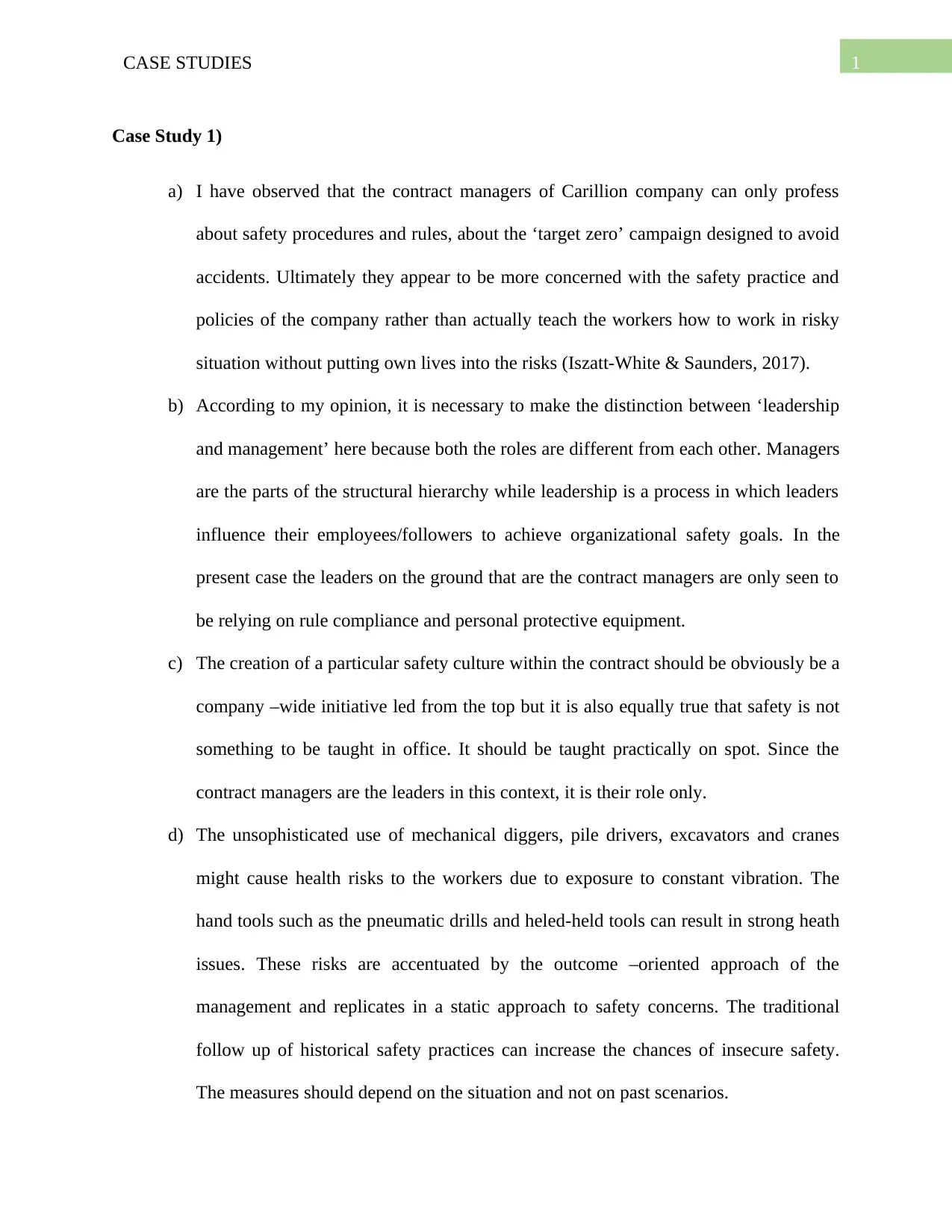
1CASE STUDIES
Case Study 1)
a) I have observed that the contract managers of Carillion company can only profess
about safety procedures and rules, about the ‘target zero’ campaign designed to avoid
accidents. Ultimately they appear to be more concerned with the safety practice and
policies of the company rather than actually teach the workers how to work in risky
situation without putting own lives into the risks (Iszatt-White & Saunders, 2017).
b) According to my opinion, it is necessary to make the distinction between ‘leadership
and management’ here because both the roles are different from each other. Managers
are the parts of the structural hierarchy while leadership is a process in which leaders
influence their employees/followers to achieve organizational safety goals. In the
present case the leaders on the ground that are the contract managers are only seen to
be relying on rule compliance and personal protective equipment.
c) The creation of a particular safety culture within the contract should be obviously be a
company –wide initiative led from the top but it is also equally true that safety is not
something to be taught in office. It should be taught practically on spot. Since the
contract managers are the leaders in this context, it is their role only.
d) The unsophisticated use of mechanical diggers, pile drivers, excavators and cranes
might cause health risks to the workers due to exposure to constant vibration. The
hand tools such as the pneumatic drills and heled-held tools can result in strong heath
issues. These risks are accentuated by the outcome –oriented approach of the
management and replicates in a static approach to safety concerns. The traditional
follow up of historical safety practices can increase the chances of insecure safety.
The measures should depend on the situation and not on past scenarios.
Case Study 1)
a) I have observed that the contract managers of Carillion company can only profess
about safety procedures and rules, about the ‘target zero’ campaign designed to avoid
accidents. Ultimately they appear to be more concerned with the safety practice and
policies of the company rather than actually teach the workers how to work in risky
situation without putting own lives into the risks (Iszatt-White & Saunders, 2017).
b) According to my opinion, it is necessary to make the distinction between ‘leadership
and management’ here because both the roles are different from each other. Managers
are the parts of the structural hierarchy while leadership is a process in which leaders
influence their employees/followers to achieve organizational safety goals. In the
present case the leaders on the ground that are the contract managers are only seen to
be relying on rule compliance and personal protective equipment.
c) The creation of a particular safety culture within the contract should be obviously be a
company –wide initiative led from the top but it is also equally true that safety is not
something to be taught in office. It should be taught practically on spot. Since the
contract managers are the leaders in this context, it is their role only.
d) The unsophisticated use of mechanical diggers, pile drivers, excavators and cranes
might cause health risks to the workers due to exposure to constant vibration. The
hand tools such as the pneumatic drills and heled-held tools can result in strong heath
issues. These risks are accentuated by the outcome –oriented approach of the
management and replicates in a static approach to safety concerns. The traditional
follow up of historical safety practices can increase the chances of insecure safety.
The measures should depend on the situation and not on past scenarios.
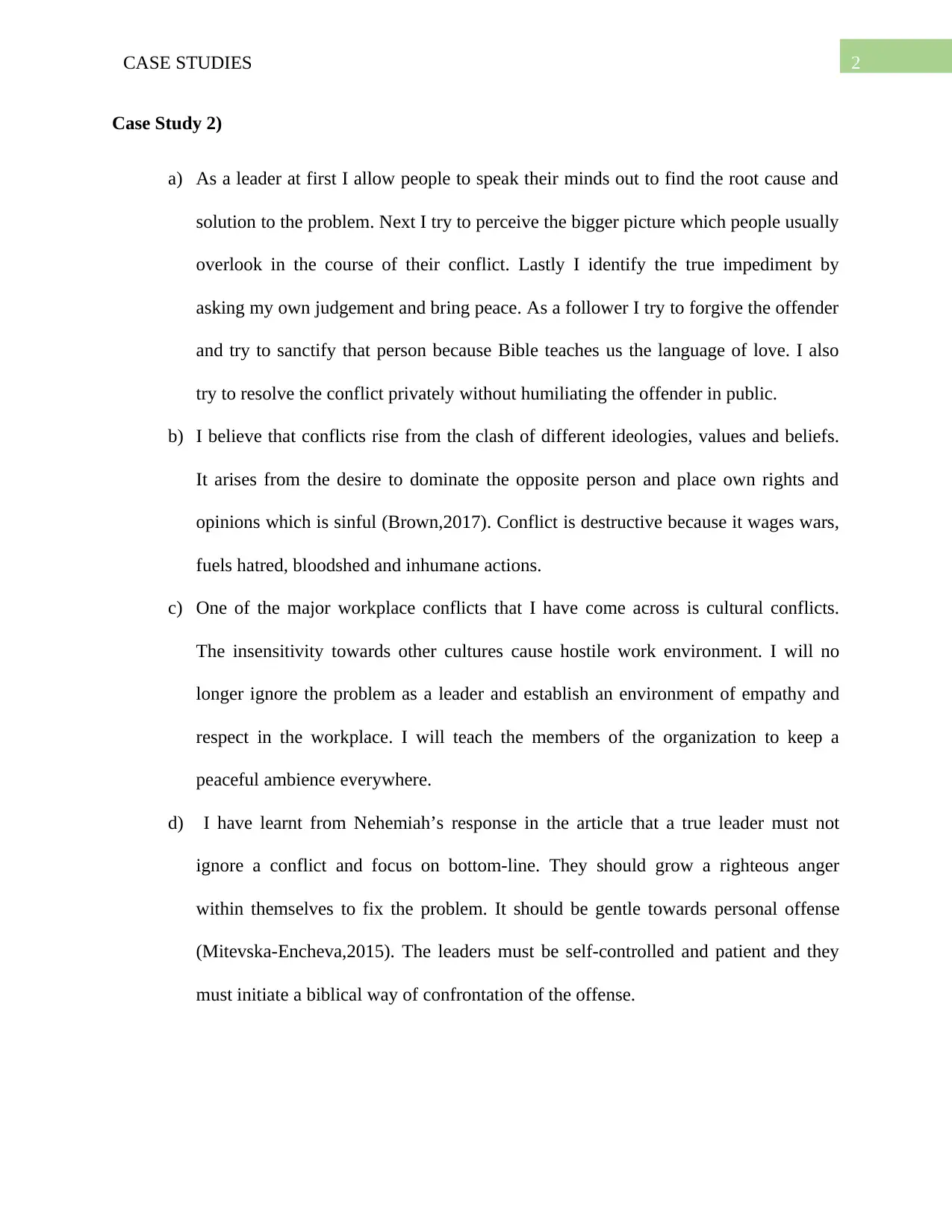
2CASE STUDIES
Case Study 2)
a) As a leader at first I allow people to speak their minds out to find the root cause and
solution to the problem. Next I try to perceive the bigger picture which people usually
overlook in the course of their conflict. Lastly I identify the true impediment by
asking my own judgement and bring peace. As a follower I try to forgive the offender
and try to sanctify that person because Bible teaches us the language of love. I also
try to resolve the conflict privately without humiliating the offender in public.
b) I believe that conflicts rise from the clash of different ideologies, values and beliefs.
It arises from the desire to dominate the opposite person and place own rights and
opinions which is sinful (Brown,2017). Conflict is destructive because it wages wars,
fuels hatred, bloodshed and inhumane actions.
c) One of the major workplace conflicts that I have come across is cultural conflicts.
The insensitivity towards other cultures cause hostile work environment. I will no
longer ignore the problem as a leader and establish an environment of empathy and
respect in the workplace. I will teach the members of the organization to keep a
peaceful ambience everywhere.
d) I have learnt from Nehemiah’s response in the article that a true leader must not
ignore a conflict and focus on bottom-line. They should grow a righteous anger
within themselves to fix the problem. It should be gentle towards personal offense
(Mitevska-Encheva,2015). The leaders must be self-controlled and patient and they
must initiate a biblical way of confrontation of the offense.
Case Study 2)
a) As a leader at first I allow people to speak their minds out to find the root cause and
solution to the problem. Next I try to perceive the bigger picture which people usually
overlook in the course of their conflict. Lastly I identify the true impediment by
asking my own judgement and bring peace. As a follower I try to forgive the offender
and try to sanctify that person because Bible teaches us the language of love. I also
try to resolve the conflict privately without humiliating the offender in public.
b) I believe that conflicts rise from the clash of different ideologies, values and beliefs.
It arises from the desire to dominate the opposite person and place own rights and
opinions which is sinful (Brown,2017). Conflict is destructive because it wages wars,
fuels hatred, bloodshed and inhumane actions.
c) One of the major workplace conflicts that I have come across is cultural conflicts.
The insensitivity towards other cultures cause hostile work environment. I will no
longer ignore the problem as a leader and establish an environment of empathy and
respect in the workplace. I will teach the members of the organization to keep a
peaceful ambience everywhere.
d) I have learnt from Nehemiah’s response in the article that a true leader must not
ignore a conflict and focus on bottom-line. They should grow a righteous anger
within themselves to fix the problem. It should be gentle towards personal offense
(Mitevska-Encheva,2015). The leaders must be self-controlled and patient and they
must initiate a biblical way of confrontation of the offense.
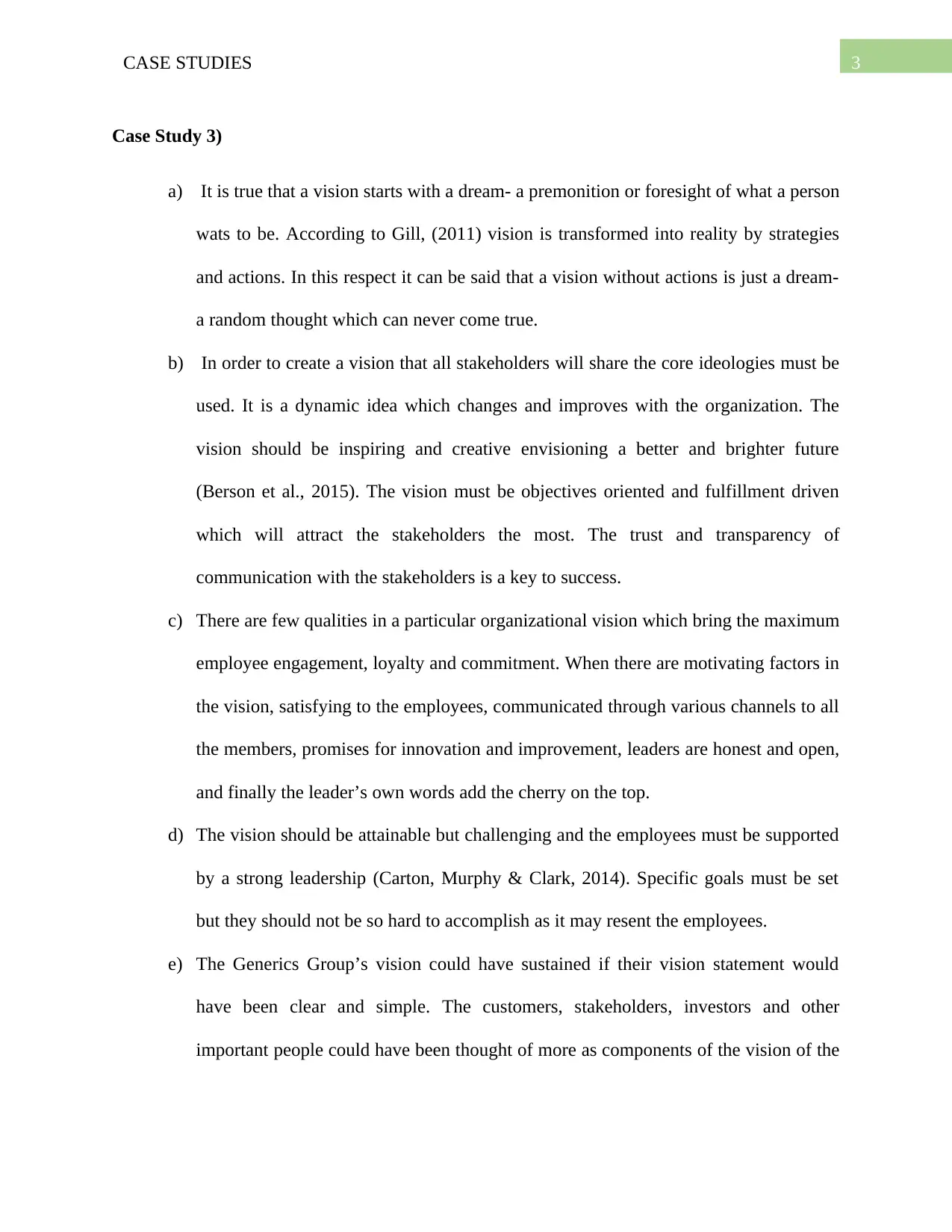
3CASE STUDIES
Case Study 3)
a) It is true that a vision starts with a dream- a premonition or foresight of what a person
wats to be. According to Gill, (2011) vision is transformed into reality by strategies
and actions. In this respect it can be said that a vision without actions is just a dream-
a random thought which can never come true.
b) In order to create a vision that all stakeholders will share the core ideologies must be
used. It is a dynamic idea which changes and improves with the organization. The
vision should be inspiring and creative envisioning a better and brighter future
(Berson et al., 2015). The vision must be objectives oriented and fulfillment driven
which will attract the stakeholders the most. The trust and transparency of
communication with the stakeholders is a key to success.
c) There are few qualities in a particular organizational vision which bring the maximum
employee engagement, loyalty and commitment. When there are motivating factors in
the vision, satisfying to the employees, communicated through various channels to all
the members, promises for innovation and improvement, leaders are honest and open,
and finally the leader’s own words add the cherry on the top.
d) The vision should be attainable but challenging and the employees must be supported
by a strong leadership (Carton, Murphy & Clark, 2014). Specific goals must be set
but they should not be so hard to accomplish as it may resent the employees.
e) The Generics Group’s vision could have sustained if their vision statement would
have been clear and simple. The customers, stakeholders, investors and other
important people could have been thought of more as components of the vision of the
Case Study 3)
a) It is true that a vision starts with a dream- a premonition or foresight of what a person
wats to be. According to Gill, (2011) vision is transformed into reality by strategies
and actions. In this respect it can be said that a vision without actions is just a dream-
a random thought which can never come true.
b) In order to create a vision that all stakeholders will share the core ideologies must be
used. It is a dynamic idea which changes and improves with the organization. The
vision should be inspiring and creative envisioning a better and brighter future
(Berson et al., 2015). The vision must be objectives oriented and fulfillment driven
which will attract the stakeholders the most. The trust and transparency of
communication with the stakeholders is a key to success.
c) There are few qualities in a particular organizational vision which bring the maximum
employee engagement, loyalty and commitment. When there are motivating factors in
the vision, satisfying to the employees, communicated through various channels to all
the members, promises for innovation and improvement, leaders are honest and open,
and finally the leader’s own words add the cherry on the top.
d) The vision should be attainable but challenging and the employees must be supported
by a strong leadership (Carton, Murphy & Clark, 2014). Specific goals must be set
but they should not be so hard to accomplish as it may resent the employees.
e) The Generics Group’s vision could have sustained if their vision statement would
have been clear and simple. The customers, stakeholders, investors and other
important people could have been thought of more as components of the vision of the
Secure Best Marks with AI Grader
Need help grading? Try our AI Grader for instant feedback on your assignments.
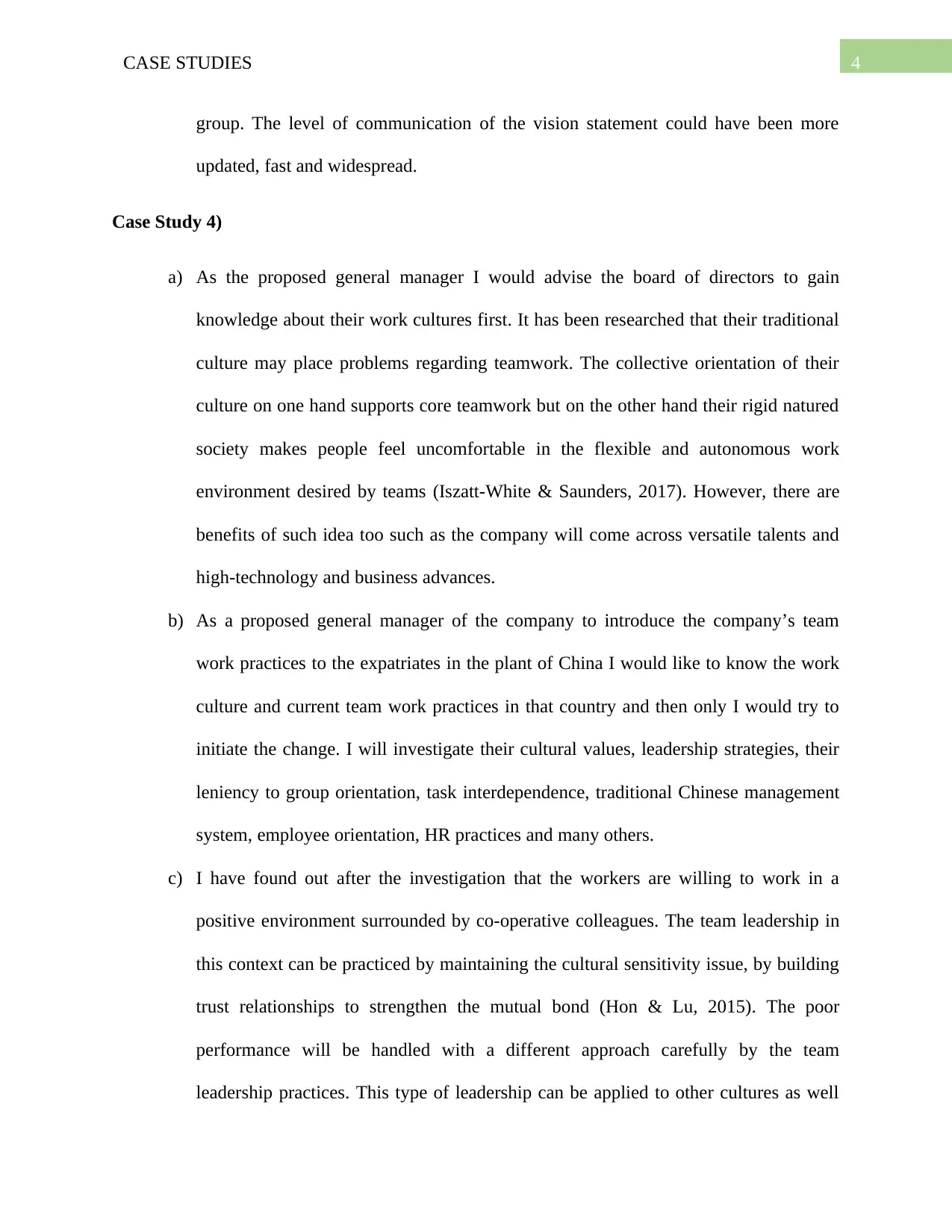
4CASE STUDIES
group. The level of communication of the vision statement could have been more
updated, fast and widespread.
Case Study 4)
a) As the proposed general manager I would advise the board of directors to gain
knowledge about their work cultures first. It has been researched that their traditional
culture may place problems regarding teamwork. The collective orientation of their
culture on one hand supports core teamwork but on the other hand their rigid natured
society makes people feel uncomfortable in the flexible and autonomous work
environment desired by teams (Iszatt-White & Saunders, 2017). However, there are
benefits of such idea too such as the company will come across versatile talents and
high-technology and business advances.
b) As a proposed general manager of the company to introduce the company’s team
work practices to the expatriates in the plant of China I would like to know the work
culture and current team work practices in that country and then only I would try to
initiate the change. I will investigate their cultural values, leadership strategies, their
leniency to group orientation, task interdependence, traditional Chinese management
system, employee orientation, HR practices and many others.
c) I have found out after the investigation that the workers are willing to work in a
positive environment surrounded by co-operative colleagues. The team leadership in
this context can be practiced by maintaining the cultural sensitivity issue, by building
trust relationships to strengthen the mutual bond (Hon & Lu, 2015). The poor
performance will be handled with a different approach carefully by the team
leadership practices. This type of leadership can be applied to other cultures as well
group. The level of communication of the vision statement could have been more
updated, fast and widespread.
Case Study 4)
a) As the proposed general manager I would advise the board of directors to gain
knowledge about their work cultures first. It has been researched that their traditional
culture may place problems regarding teamwork. The collective orientation of their
culture on one hand supports core teamwork but on the other hand their rigid natured
society makes people feel uncomfortable in the flexible and autonomous work
environment desired by teams (Iszatt-White & Saunders, 2017). However, there are
benefits of such idea too such as the company will come across versatile talents and
high-technology and business advances.
b) As a proposed general manager of the company to introduce the company’s team
work practices to the expatriates in the plant of China I would like to know the work
culture and current team work practices in that country and then only I would try to
initiate the change. I will investigate their cultural values, leadership strategies, their
leniency to group orientation, task interdependence, traditional Chinese management
system, employee orientation, HR practices and many others.
c) I have found out after the investigation that the workers are willing to work in a
positive environment surrounded by co-operative colleagues. The team leadership in
this context can be practiced by maintaining the cultural sensitivity issue, by building
trust relationships to strengthen the mutual bond (Hon & Lu, 2015). The poor
performance will be handled with a different approach carefully by the team
leadership practices. This type of leadership can be applied to other cultures as well
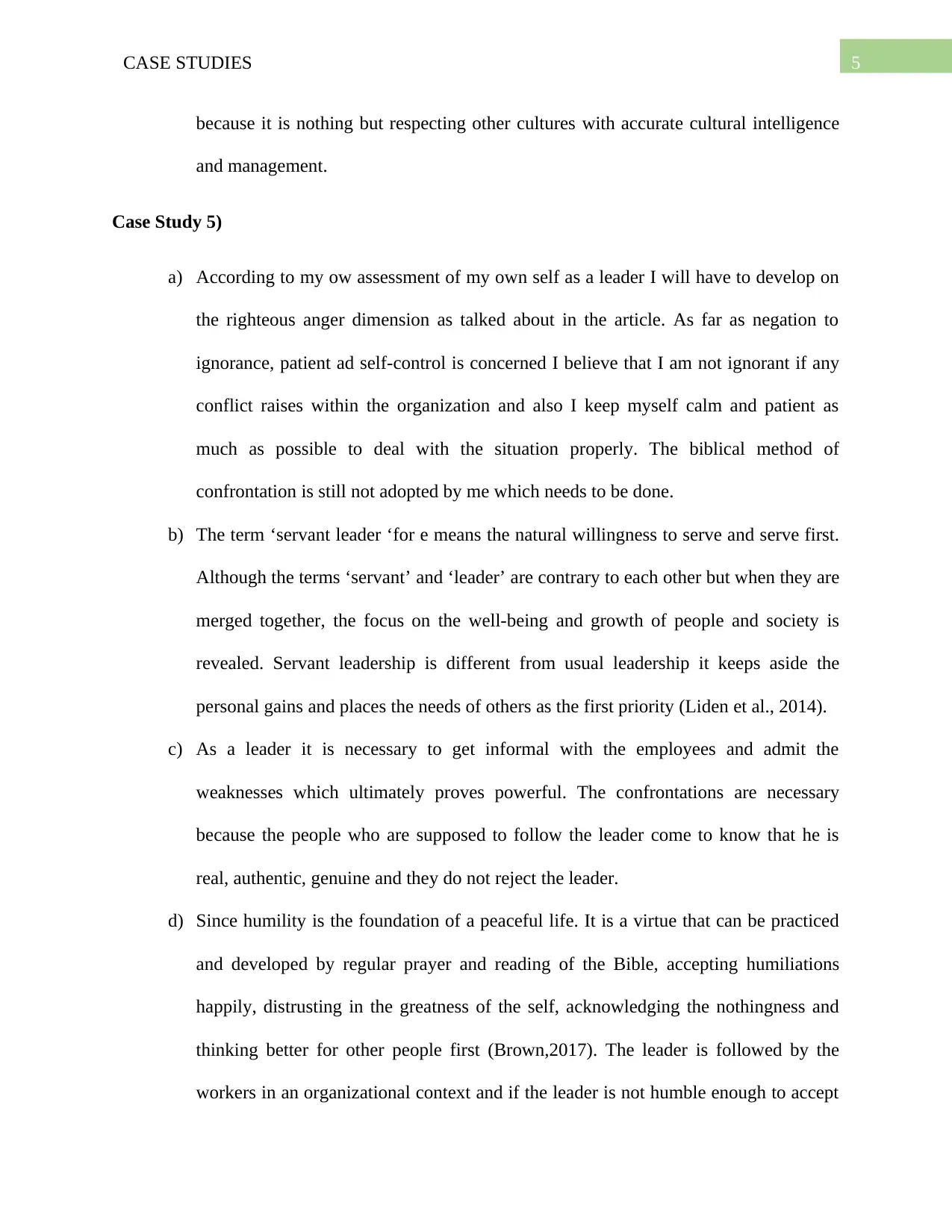
5CASE STUDIES
because it is nothing but respecting other cultures with accurate cultural intelligence
and management.
Case Study 5)
a) According to my ow assessment of my own self as a leader I will have to develop on
the righteous anger dimension as talked about in the article. As far as negation to
ignorance, patient ad self-control is concerned I believe that I am not ignorant if any
conflict raises within the organization and also I keep myself calm and patient as
much as possible to deal with the situation properly. The biblical method of
confrontation is still not adopted by me which needs to be done.
b) The term ‘servant leader ‘for e means the natural willingness to serve and serve first.
Although the terms ‘servant’ and ‘leader’ are contrary to each other but when they are
merged together, the focus on the well-being and growth of people and society is
revealed. Servant leadership is different from usual leadership it keeps aside the
personal gains and places the needs of others as the first priority (Liden et al., 2014).
c) As a leader it is necessary to get informal with the employees and admit the
weaknesses which ultimately proves powerful. The confrontations are necessary
because the people who are supposed to follow the leader come to know that he is
real, authentic, genuine and they do not reject the leader.
d) Since humility is the foundation of a peaceful life. It is a virtue that can be practiced
and developed by regular prayer and reading of the Bible, accepting humiliations
happily, distrusting in the greatness of the self, acknowledging the nothingness and
thinking better for other people first (Brown,2017). The leader is followed by the
workers in an organizational context and if the leader is not humble enough to accept
because it is nothing but respecting other cultures with accurate cultural intelligence
and management.
Case Study 5)
a) According to my ow assessment of my own self as a leader I will have to develop on
the righteous anger dimension as talked about in the article. As far as negation to
ignorance, patient ad self-control is concerned I believe that I am not ignorant if any
conflict raises within the organization and also I keep myself calm and patient as
much as possible to deal with the situation properly. The biblical method of
confrontation is still not adopted by me which needs to be done.
b) The term ‘servant leader ‘for e means the natural willingness to serve and serve first.
Although the terms ‘servant’ and ‘leader’ are contrary to each other but when they are
merged together, the focus on the well-being and growth of people and society is
revealed. Servant leadership is different from usual leadership it keeps aside the
personal gains and places the needs of others as the first priority (Liden et al., 2014).
c) As a leader it is necessary to get informal with the employees and admit the
weaknesses which ultimately proves powerful. The confrontations are necessary
because the people who are supposed to follow the leader come to know that he is
real, authentic, genuine and they do not reject the leader.
d) Since humility is the foundation of a peaceful life. It is a virtue that can be practiced
and developed by regular prayer and reading of the Bible, accepting humiliations
happily, distrusting in the greatness of the self, acknowledging the nothingness and
thinking better for other people first (Brown,2017). The leader is followed by the
workers in an organizational context and if the leader is not humble enough to accept

6CASE STUDIES
embarrassment in any situation, the follower cannot be expected to admit their follies
and mitigate conflicts to establish a peaceful work environment.
embarrassment in any situation, the follower cannot be expected to admit their follies
and mitigate conflicts to establish a peaceful work environment.
Paraphrase This Document
Need a fresh take? Get an instant paraphrase of this document with our AI Paraphraser
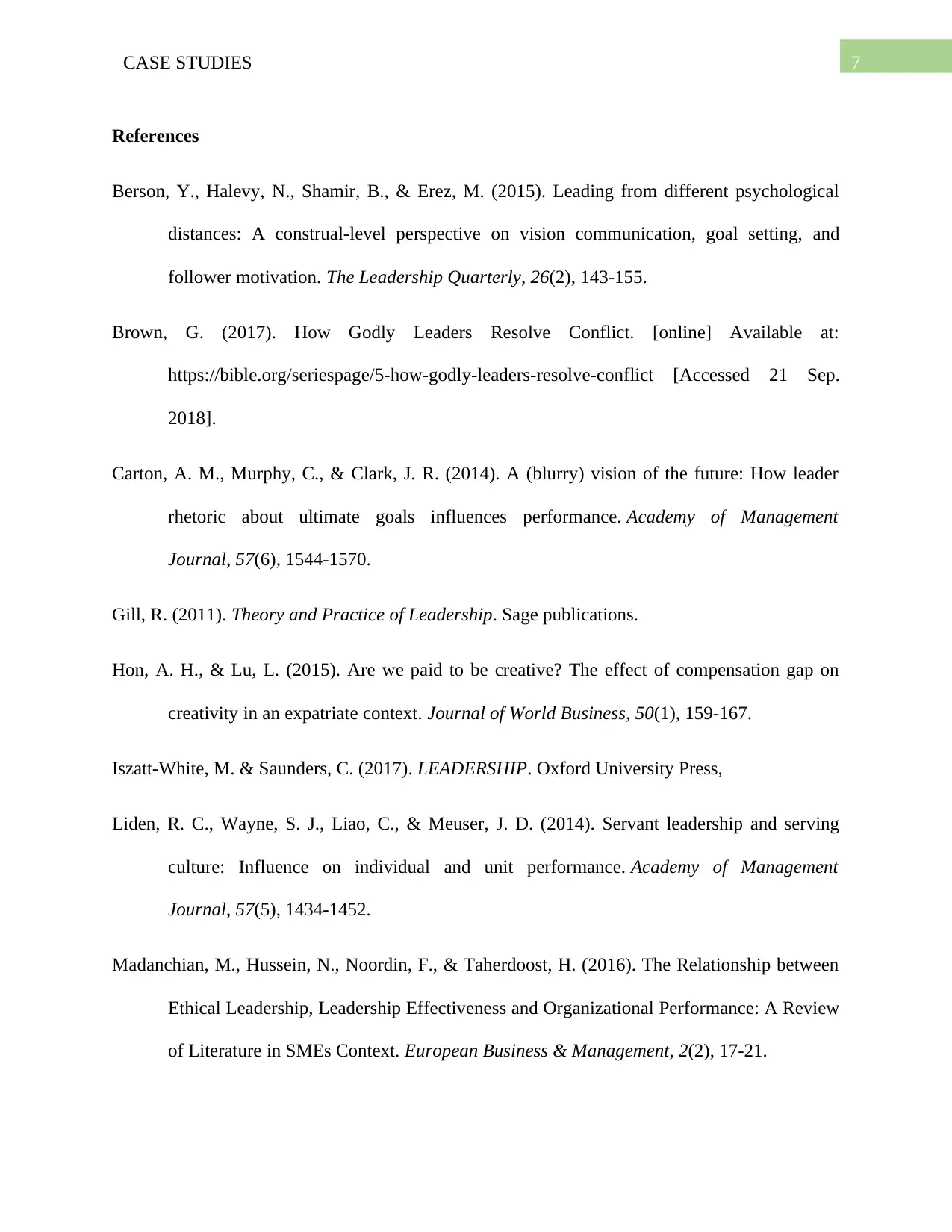
7CASE STUDIES
References
Berson, Y., Halevy, N., Shamir, B., & Erez, M. (2015). Leading from different psychological
distances: A construal-level perspective on vision communication, goal setting, and
follower motivation. The Leadership Quarterly, 26(2), 143-155.
Brown, G. (2017). How Godly Leaders Resolve Conflict. [online] Available at:
https://bible.org/seriespage/5-how-godly-leaders-resolve-conflict [Accessed 21 Sep.
2018].
Carton, A. M., Murphy, C., & Clark, J. R. (2014). A (blurry) vision of the future: How leader
rhetoric about ultimate goals influences performance. Academy of Management
Journal, 57(6), 1544-1570.
Gill, R. (2011). Theory and Practice of Leadership. Sage publications.
Hon, A. H., & Lu, L. (2015). Are we paid to be creative? The effect of compensation gap on
creativity in an expatriate context. Journal of World Business, 50(1), 159-167.
Iszatt-White, M. & Saunders, C. (2017). LEADERSHIP. Oxford University Press,
Liden, R. C., Wayne, S. J., Liao, C., & Meuser, J. D. (2014). Servant leadership and serving
culture: Influence on individual and unit performance. Academy of Management
Journal, 57(5), 1434-1452.
Madanchian, M., Hussein, N., Noordin, F., & Taherdoost, H. (2016). The Relationship between
Ethical Leadership, Leadership Effectiveness and Organizational Performance: A Review
of Literature in SMEs Context. European Business & Management, 2(2), 17-21.
References
Berson, Y., Halevy, N., Shamir, B., & Erez, M. (2015). Leading from different psychological
distances: A construal-level perspective on vision communication, goal setting, and
follower motivation. The Leadership Quarterly, 26(2), 143-155.
Brown, G. (2017). How Godly Leaders Resolve Conflict. [online] Available at:
https://bible.org/seriespage/5-how-godly-leaders-resolve-conflict [Accessed 21 Sep.
2018].
Carton, A. M., Murphy, C., & Clark, J. R. (2014). A (blurry) vision of the future: How leader
rhetoric about ultimate goals influences performance. Academy of Management
Journal, 57(6), 1544-1570.
Gill, R. (2011). Theory and Practice of Leadership. Sage publications.
Hon, A. H., & Lu, L. (2015). Are we paid to be creative? The effect of compensation gap on
creativity in an expatriate context. Journal of World Business, 50(1), 159-167.
Iszatt-White, M. & Saunders, C. (2017). LEADERSHIP. Oxford University Press,
Liden, R. C., Wayne, S. J., Liao, C., & Meuser, J. D. (2014). Servant leadership and serving
culture: Influence on individual and unit performance. Academy of Management
Journal, 57(5), 1434-1452.
Madanchian, M., Hussein, N., Noordin, F., & Taherdoost, H. (2016). The Relationship between
Ethical Leadership, Leadership Effectiveness and Organizational Performance: A Review
of Literature in SMEs Context. European Business & Management, 2(2), 17-21.

8CASE STUDIES
Mitevska-Encheva, M. (2015). FACTORS TO OVERCOME ORGANIZATIONAL
CONFLICTS IN DIFFERENT CULTURAL ENVIROMENTS. International Journal of
Arts & Sciences, 8(3), 211.
Mitevska-Encheva, M. (2015). FACTORS TO OVERCOME ORGANIZATIONAL
CONFLICTS IN DIFFERENT CULTURAL ENVIROMENTS. International Journal of
Arts & Sciences, 8(3), 211.
1 out of 9
Related Documents
Your All-in-One AI-Powered Toolkit for Academic Success.
+13062052269
info@desklib.com
Available 24*7 on WhatsApp / Email
![[object Object]](/_next/static/media/star-bottom.7253800d.svg)
Unlock your academic potential
© 2024 | Zucol Services PVT LTD | All rights reserved.





